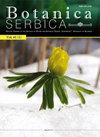Physiological responses of bread and durum wheat seeds to osmotic stress and salinity in the early germination stage
IF 1.1
4区 生物学
Q4 PLANT SCIENCES
引用次数: 0
Abstract
Determining the mechanisms underlying tolerance to osmotic stress and salinity during the germination period is an essential task in order to improve agricultural production in arid and semi-arid areas. In this work, the seeds of bread and durum wheat cultivars were treated with different concentrations of polyethylene glycol (PEG)-6000 and NaCl for 1 week, and half-maximal inhibitory concentrations (IC50) of germination were calculated. The seeds were then exposed to IC50 values of NaCl and PEG-6000 for 2 days in order to assess their physiological and biochemical properties. Alpha and beta amylase enzyme activities, the reducing sugar, total sugar, proline, protein, and H2O2 contents, and DPPH radical scavenging activity of the seeds were determined by spectrophotometric methods. The results showed that the bread wheat seeds had a much higher tolerance to excess salt and osmotic stress than the durum wheat seeds. In particular, the average IC50 value of NaCl for the bread wheat cultivars was almost twice that for the durum wheat cultivars. The imbibition test revealed that the water uptake capacity of the seeds did not explain the difference in tolerance to these stress conditions. On the other hand, the bread wheat seeds exhibited constitutively higher proline, total sugar, and H2O2 contents as well as antioxidant capacity compared to the durum wheat seeds (p < 0.05). In conclusion, the current findings suggest that the interplay of oxidative metabolism and compatible solutes may contribute to improving germination tolerance under water deficit and salinity conditions in wheat.面包和硬粒小麦种子萌发初期对渗透胁迫和盐度的生理响应
确定种子萌发期耐渗透胁迫和耐盐的机制是提高干旱半干旱地区农业生产水平的重要任务。以不同浓度聚乙二醇(PEG)-6000和NaCl处理面包小麦和硬粒小麦品种种子1周,计算萌发抑制浓度(IC50)。然后将种子置于NaCl和PEG-6000的IC50值下处理2 d,以评价其生理生化特性。采用分光光度法测定种子α和β淀粉酶活性,还原糖、总糖、脯氨酸、蛋白质和H2O2含量,以及DPPH自由基清除活性。结果表明,面包小麦种子对过量盐和渗透胁迫的耐受性明显高于硬粒小麦种子。其中,面包小麦品种的平均NaCl IC50值几乎是硬粒小麦品种的2倍。吸胀试验表明,种子的吸水能力不能解释对这些胁迫条件的耐受性差异。另一方面,面包小麦种子的脯氨酸、总糖、H2O2含量和抗氧化能力均高于硬粒小麦种子(p <0.05)。综上所述,目前的研究结果表明,氧化代谢和相容溶质的相互作用可能有助于提高小麦在缺水和盐度条件下的发芽耐受性。
本文章由计算机程序翻译,如有差异,请以英文原文为准。
求助全文
约1分钟内获得全文
求助全文
来源期刊

Botanica Serbica
Agricultural and Biological Sciences-Plant Science
CiteScore
1.40
自引率
12.50%
发文量
17
审稿时长
34 weeks
期刊介绍:
Botanica Serbica publishes original research papers on all aspects of plant, fungal and microbial biology research including the disciplines of microbiology, mycology, lichenology, bryology, flora, vegetation, biogeography, systematics, taxonomy, plant biotechnology, plant cell biology, plant ecology, environmental plant biology, forestry, genomics, horticulture, limnology, metabolomics, molecular biology, proteomics, virology, plant conservation and protection, and wildlife and ecosystem management.
 求助内容:
求助内容: 应助结果提醒方式:
应助结果提醒方式:


